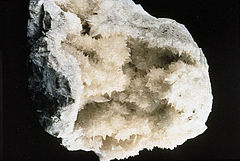- Colemanite
-
For the community in California formerly named Colemanite, see Ryan, California.
Colemanite 
General Category Inoborates Chemical formula CaB3O4(OH)3·H2O Strunz classification 06.CB.10 Crystal symmetry Monoclinic 2/m Unit cell a = 8.712(2) Å, b = 11.247(3) Å, c = 6.091(1) Å; β = 110.12°; Z = 4 Identification Color Colorless, white, yellowish, grey Crystal habit Massive granular to coarsely crystalline, most commonly nodular. Crystal system Monoclinic - Prismatic Cleavage [010] perfect, [001] distinct Fracture Brittle uneven to subconchoidal Mohs scale hardness 4.5 Luster Vitreous Streak White Diaphaneity Transparent to translucent Specific gravity 2.42 Optical properties Biaxial (+) Refractive index nα = 1.586 nβ = 1.592 nγ = 1.614 Birefringence δ = 0.028 Fusibility 1.5 Diagnostic features Exfoliates on heating, produces a green flame Other characteristics Bright pale yellow fluorescence, may phosphoresce pale green; pyroelectric and piezoelectric at very low temperature. References [1][2][3][4] Colemanite (CaB3O4(OH)3·H2O) is a borate mineral found in evaporite deposits of alkaline lacustrine environments. Colemanite is a secondary mineral that forms by alteration of borax and ulexite.[1]
It was first described in 1884 for an occurrence near Furnace Creek in Death Valley and was named after William Tell Coleman (1824–1893), owner of the mine Harmony Borax Works where it was first found.[2] At the time, Coleman had alternatively proposed the name "smithite" instead after his business associate Francis Marion Smith.[5]
See also
References
- ^ a b Klein, Cornelis and Cornelius S. Hurlbut, Jr.; 1985, Manual of Mineralogy, Wiley, 20th ed., p. 347 ISBN 0-471-80580-7
- ^ a b http://www.mindat.org/min-1108.html Mindat
- ^ http://webmineral.com/data/Colemanite.shtml Webmineral
- ^ http://rruff.geo.arizona.edu/doclib/hom/colemanite.pdf Handbook of Mineralogy
- ^ Hildebrand, GH. (1982) Borax Pioneer: Francis Marion Smith. San Diego: Howell-North Books. p 31 ISBN 0-8310-7148-6
- R. F. Gallup1 and L. B. Coleman (1990). "Vibrational spectra and the ferroelectric phase transition of colemanite". Physics and Chemistry of Minerals 17 (3): 271–274. doi:10.1007/BF00201460.
- "Death Valley - Historic Resource Study - A History of Mining". http://www.nps.gov/history/history/online_books/deva/section3e1.htm.
External links
 Chisholm, Hugh, ed (1911). "Colemanite". Encyclopædia Britannica (11th ed.). Cambridge University Press.
Chisholm, Hugh, ed (1911). "Colemanite". Encyclopædia Britannica (11th ed.). Cambridge University Press.
This article about a specific mineral or mineraloid is a stub. You can help Wikipedia by expanding it.
